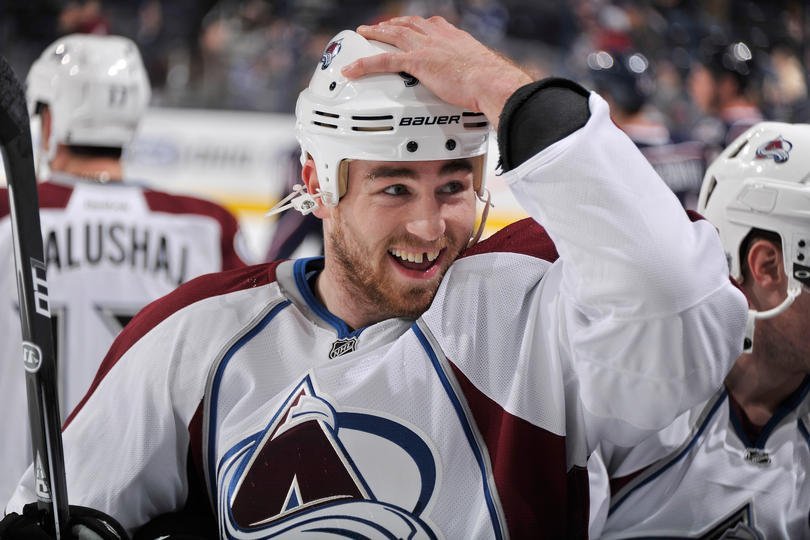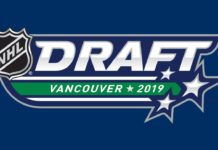Fans of the Blue and White who have yearned for a bona fide first line centre since the departure of Mats Sundin (for a forgettable half season with the Vancouver Canucks) had their ears perk up this week when it was announced that the Colorado Avalanche filed for Club-Elected salary arbitration with Ryan O’Reilly.
In case you’re unfamiliar with O’Reilly, he’s the 6 foot tall, 200lb and 23 year old centre who put up 28 goals and 36 assists this past season playing around 20 minutes a night, while averaging just under a point per game and north of 21 minutes a night in the playoffs.
Nothing yet? He’s also the player that the Calgary Flames signed to a 2 year $10 million offer sheet that was matched by the Avalanche and that saw him earn $6.5 million this past season, with a $5 million dollar annual cap hit. Oh right, that Ryan O’Reilly.
It’s precisely that $6.5 million salary figure that brings us to the arbitration process. Thanks to Article 10.2(a)(ii)(D) of the Collective Bargaining Agreement (“CBA”), and as a Group 2 Restricted Free Agent, the Colorado Avalanche must offer Ryan O’Reilly a minimum of $6.5 million dollars next season in order to qualify him and retain his rights. Thank.you.very.much.Calgary. At 23 years old, and with improvements across almost all major statistical categories, including an improving shooting percentage, this is a player that is just coming into his own and an asset the Avalanche simply cannot afford to lose for nothing.
So why are they taking O’Reilly to arbitration and how will the process work?
A. Overview of the Arbitration Process
First things first, let’s take a quick look at how the NHL’s arbitration process shakes out. The salary arbitration system is provided by Article 12 of the CBA and states that as a 23 year old restricted free agent with a minimum of 2 years of professional experience, Ryan O’Reilly is eligible for player or club elected salary arbitration.
In Player-Elected salary arbitration the player chooses to submit his case to an arbitrator in the hope of securing greater compensation in his next contract over the next 1-2 seasons. Generally this arises where the player believes he has a strong case for a raise, and yet he is unable to secure one from his club. In Club-Elected salary arbitration, it is the club that chooses to arbitrate the player’s next contract for reasons that are very much the opposite of what you’d see in a player elected arbitration. Namely, the club believes that the player is asking for too much, and that an objective third party will award the player a salary more in-line with the club’s offer.
Specifically in O’Reilly’s case, Article 12.3(a) provides that players’ whose aggregate salary (including base and signing, roster and reporting bonuses) was greater than $1.75 million in the previous season are eligible for Club-Elected salary arbitration.
By virtue of Article 12.4, a Club may choose to proceed to Club-Elected salary arbitration as long as a written request is filed (in approved form) by the later of June 15th or 48 hours after the Stanley Cup final, and notice is provided to the player, the player’s certified agent, the NHLPA and the NHL. Interestingly, Article 12.3(c) provides that a player can only be subject to Club-Elected salary arbitration once in his career, and that any further elections in respect of that player will be deemed null and void. This is it for O’Reilly.
So what does it mean now that the Avalanche have filed for salary arbitration? Well for starters, by virtue of Article 12.3(a)(i) it means that they no longer have to qualify O’Reilly at a minimum of $6.5 million next season because the act of filing for Club-Elected salary arbitration can be done in lieu of extending the qualifying offer. In fact, if the Avalanche are successful at the arbitration the arbitrator can award O’Reilly a salary as low as $5.525 million, or 85% of last year’s salary. So there is the chance that they could retain O’Reilly next season for less than what he was actually paid last year, albeit with a greater cap hit.
As you can see, filing for Club-Elected arbitration is a fairly low-risk move (in the short-term) that allows the Avalanche to maintain O’Reilly’s rights while they continue to negotiate with him until late July when the arbitration hearing is set to take place, while not being stuck qualifying him at $6.5 million next year.
Realistically, what this has done is allow the Avalanche to continue to negotiate with O’Reilly over the next month toward a long-term agreement that will likely see O’Reilly earn between $5.75 and $6.5 million over 6 to 7 seasons, all the while applying pressure by setting a drop-dead date in the form of the binding arbitration hearing. Applying this kind of pressure is a fairly classic negotiating tactic, and the smart money is on a Nugent-Hopkins type deal that sees O’Reilly take home $6 million a season for 7 seasons being completed before arbitration. This is not exciting news for Leafs fans.
B. Where it Could get Interesting
There are two wrinkles, however, that have the potential to make the O’Reilly situation interesting. The first is that, Article 12.3(a)(iv) states that by virtue of being subject to a Club-Elected salary arbitration, O’Reilly is eligible to sign an offer sheet between now and July 5th, 2014 with one of the 29 other NHL clubs. At a presumed average salary of $6 to $6.5 million, that means a club would have to be prepared to surrender a 1st, 2nd and 3rd round draft pick in next season’s draft if Colorado didn’t match the offer. In fact, Article 10.4 provides that based on current salary figures the offering team could sign O’Reilly to an average value of up to $6,728,781 per season before the compensation increases to two 1st’s, a 2nd and a 3rd. (Sorry Leafs fans, the Leafs currently do not own their 2nd round draft pick next year because of the Bernier trade).
We saw Colorado match an offer sheet that paid O’Reilly $6.5 million last season (but with a $5 million cap hit) within hours of receiving in, but do they automatically match an offer that sees him carry an average cap hit of $6.5 million+; especially when they’d ideally like to retain Statsny (their best two-way centre, and currently taking home $6.6 million) and will need to re-up super rookie Nathan Mackinnon in a couple of seasons? Food for thought.
The second way that this could get interesting is if O’Reilly and the Avalanche continue to negotiate but fail to reach a deal and this actually heads to arbitration. Article 12.9 states that Club-Elected salary arbitrations proceed as follows:
-
The case of the club and the NHL;
-
the case of the player and the NHLPA;
-
rebuttal and closing of the club and the NHL;
-
rebuttal and closing of the player and the NHLPA; and
-
surrebuttal by the club and NHL if applicable.
In establishing their case, the club and the NHL are permitted to lead all sorts of evidence, including:
- Performance as determined by official NHL statistics (does not include Corsi and Fenwick, which aren’t officially NHL maintained statistics);
- the number of games played, injuries and illnesses during the preceding seasons;
- the length of service of the player with the league and/or club;
- the overall contribution to the competitive success or failure of the club in preceding seasons;
- any special qualities of leadership or public appeal not inconsistent with the fulfillment of his responsibilities as a playing member of his team; and
- the overall performance of allegedly comparable players in the preceding seasons and their compensation.
As an aside, the club and the NHL cannot lead evidence of: (i) the team’s financial position; (ii) previous unsuccessful negotiations with the player; and (iii) video, media reports and testimonials.
Admissible evidence can be presented by affidavit (written sworn testimony), live witnesses and any other relevant documents in the possession of the club.
What you should take away from the above is that in trying to reduce the compensation of the player who is the subject of the arbitration the club will lead evidence from various club officials who will downplay positive statistics, focus on propensity for injury or illness, diminish the player’s contribution to the competitive success of the club (or focus on his contribution to the club’s failure, if applicable), downplay any leadership or community involvement undertaken by the player, while simultaneously boosting the profile of comparable players in an effort to justify why this particular player should be paid less than his peers. Sound like fun?
In the worst case scenario at the end of all of that one of the NHL/NHLPA’s 8 pre-selected arbitrators may well turn around and force the athlete to play for the club (for 1 or two seasons depending on the player’s election prior to the hearing) at what might be only 85% of last season’s salary (although this is rare). Does this sound like a recipe for an enduring positive relationship between O’Reilly and the Avalanche, especially in light of how his previous negotiations have unfolded?
After the close of the hearing, the arbitrator has 48 hours to reach a decision and communicate it to the club and the player. In a Club-Elected salary arbitration, the CBA does not provide either of the club or the player with the right to walk-away from the award, so if this does proceed to arbitration O’Reilly will be with the Avalanche for next season.
If, in fact, this does proceed to arbitration I cannot see O’Reilly choosing anything but the one year deal, given his negotiation history and the likely fall-out from the arbitration process, so he and the Avalanche will likely be right back here next off-season, but without the Avalanche holding the bargaining hammer of Club-Elected arbitration. In other words, this is likely the one chance for the Avalanche to get O’Reilly signed to a long-term deal that makes sense for both sides, failing which this player will likely be on the move next off-season.
C. The Bottom Line
The rising NHL cap, which is expected to hit or exceed $69 million next season means that more than a couple of NHL clubs will have the financial wherewithal to take a run at O’Reilly with an offer-sheet leading up to July 5th. Given that the likely compensation is a 1st, 2nd, and 3rd round draft pick, it would make sense from an asset maximization stand-point for one of the 29 other NHL clubs to sign O’Reilly up. However, the rising cap also means that Colorado will have the means to match the offer, which they have shown a decided willingness to do with this player. The reality is, in the modern NHL clubs simply do not let go of premier young talent, especially at centre ice, and O’Reilly is likely to be signed before this heads to arbitration, or else sign an offer sheet that is ultimately matched by Colorado.
Sorry Leafs fans; better off hoping we trade up and draft Sam Bennett.

































![New Leaf Anthony Stolarz on the opportunity in Toronto: “In Florida, I knew my role as a backup… Now, [Joseph Woll] and I are competing for starts… As a goalie, that’s all you can ask for” Anthony Stolarz, Stanley Cup win, now Maple Leaf](https://mapleleafshotstove.com/wp-content/uploads/2024/07/anthony-stolarz-sc-100x70.jpg)
